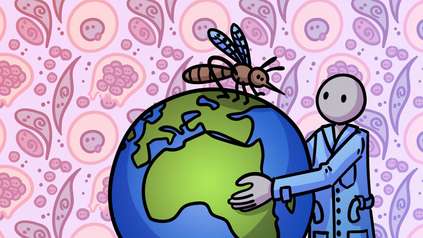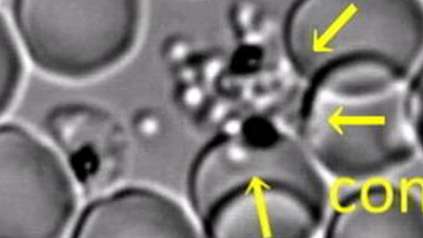Resurrection of over 50,000-year-old gene reveals how malaria parasite jumped from gorillas to humans
For the first time, scientists have uncovered the likely series of events that led to the world’s deadliest malaria parasite being able to jump from gorillas to humans. Researchers at the Wellcome Sanger Institute and the University of Montpellier reconstructed an approximately 50,000-year-old gene sequence that was acquired by the ancestor of Plasmodium falciparum, giving it the ability to infect human red blood cells.
They found that this rh5 gene enabled the parasite to infect both gorillas and humans for a limited time, explaining how the jump was made at a molecular level. The team also identified the specific DNA mutation that subsequently restricted P. falciparum to humans.
The study, published today (15 October 2019) in PLOS Biology, provides a plausible molecular explanation for how one of the world’s most deadly infectious diseases came to infect humans, and will be important more generally for understanding how pathogens are able to jump from one species to another.
Malaria remains a major global health problem causing an estimated 435,000 deaths per year, with 61 per cent occurring in children under five years of age. P. falciparum is the species of parasite that is responsible for the most deadly form of malaria and is particularly prevalent in Africa, where it accounted for 99.7 per cent of malaria cases in 2017*.
P. falciparum is one of seven species of parasite that can cause malaria in a family known as the Laverania. These parasites originated in African great apes and today are restricted to their own specific host species, with three parasite species confined to chimpanzees and three to gorillas. The seventh, P. falciparum, only infects humans, after switching host from gorillas through a process known as zoonosis around 50,000 years ago.
Genome sequencing of all seven Laverania parasite species revealed a section of DNA that had transferred from a gorilla parasite, Plasmodium adleri, to the ancestor of P. falciparum. This DNA sequence included a gene called rh5. This gene produces the protein RH5, which binds to a protein receptor in human red blood cells called basigin.
This RH5-basigin interaction is critical for the P. falciparum parasite to infect humans. As such, RH5 is a promising malaria vaccine target – if this interaction can be disrupted, the parasite would no longer be able to invade human red blood cells and cause malaria.
To further investigate the origin of P. falciparum, researchers at the University of Montpellier used ancestral sequence reconstruction** to ‘resurrect’ the RH5 DNA sequence that was transferred to the ancestor of P. falciparum around 50,000 years ago. Synthetic copies of the ancestral rh5 gene were created in the laboratory by scientists at the Wellcome Sanger Institute, where the molecular interactions of the RH5 protein could be observed.
Researchers had expected that the transferred RH5 protein would bind only gorilla basigin, but remarkably this protein had the dual property of being able to bind both gorilla and human basigin. This immediately suggested how the parasite could switch host.
“The fact that this ancestral RH5 protein was able to bind to the red blood cell receptor basigin from both humans and gorillas, immediately provided a molecular explanation for how Plasmodium falciparum evolved to infect humans.”
Dr Francis Galaway First author of the study from the Wellcome Sanger Institute
Subsequently, the researchers were able to identify six differences between the ancestral RH5 sequence and the current sequence in P. falciparum. One of these mutations was found to result in the complete loss of the ability to bind to gorilla basigin, explaining how P. falciparum became restricted to humans.
It’s fascinating to be able to ‘resurrect’ ancestral genes such as the one which allowed Plasmodium falciparum to jump from gorillas to humans. We’ve discovered not only how a species host switch has occurred, but the individual mutation which has then restricted P. falciparum to a single host species.”
Dr Franck Prugnolle Co-lead author from the University of Montpellier
When diseases, such as influenza or malaria, jump from animals to humans in this way it is known as a zoonosis. It occurs when pathogens that are already able to infect an animal host acquire genetic material that enables them to also infect humans. In the case of P. falciparum malaria, it is thought that the genetic transfer of the rh5 gene occurred when a gorilla cell became infected with two species of Plasmodium parasite simultaneously – an event known as an introgression. When an introgression occurs, genetic material is swapped from one species to another.
The type of introgression event that is presumed to have resulted in P. falciparum jumping from gorillas to humans is incredibly rare. Among the seven Laverania species, comparative genome analysis has revealed just a few instances over a span of around one million years where a sequence of DNA was transferred from one parasite to another.
“In the history of mankind, Plasmodium falciparum malaria has arguably been responsible for more human deaths than any other disease. So it is both important and fascinating to understand the molecular pathways that enabled this deadly parasite to infect humans.”
Dr Gavin Wright Lead author of the study and Senior Group Leader at the Wellcome Sanger Institute
More information
Notes to Editors
*For more information on these figures and the state of malaria in general, see the WHO World Malaria Report 2018 https://www.who.int/malaria/publications/world-malaria-report-2018/report/en/
**An overview on ancestral sequence reconstruction is available on Wikipedia https://en.wikipedia.org/wiki/Ancestral_sequence_reconstruction
Link to study:
Galaway F, Yu R, Constantinou A, Prugnolle F, Wright GJ. (2019). Resurrection of the ancestral RH5 invasion ligand provides a molecular explanation for the origin of P. falciparum malaria in humans. PLoS Biol 17(10): e3000490. https://doi.org/10.1371/journal.pbio.3000490
Funding:
This work was funded by Wellcome and Labex CEMEB.
Selected websites
Laboratoire MIGEVEC, University of Montpellier
Laboratoire MIVEGEC is a world leading centre for research on the ecology and evolution of diseases (infectious and non-infectious).
About the Wellcome Sanger Institute
The Wellcome Sanger Institute is a world-leading genomics research centre. We undertake large-scale research that forms the foundations of knowledge in biology and medicine. We are open and collaborative; our data, results, tools and technologies are shared across the globe to advance science. Our ambition is vast – we take on projects that are not possible anywhere else. We use the power of genome sequencing to understand and harness the information in DNA. Funded by Wellcome, we have the freedom and support to push the boundaries of genomics. Our findings are used to improve health and to understand life on Earth. Find out more at www.sanger.ac.uk or follow us on Twitter, Facebook, LinkedIn and on our Blog.
About Wellcome
Wellcome exists to improve health by helping great ideas to thrive. We support researchers, we take on big health challenges, we campaign for better science, and we help everyone get involved with science and health research. We are a politically and financially independent foundation. https://wellcome.org/




